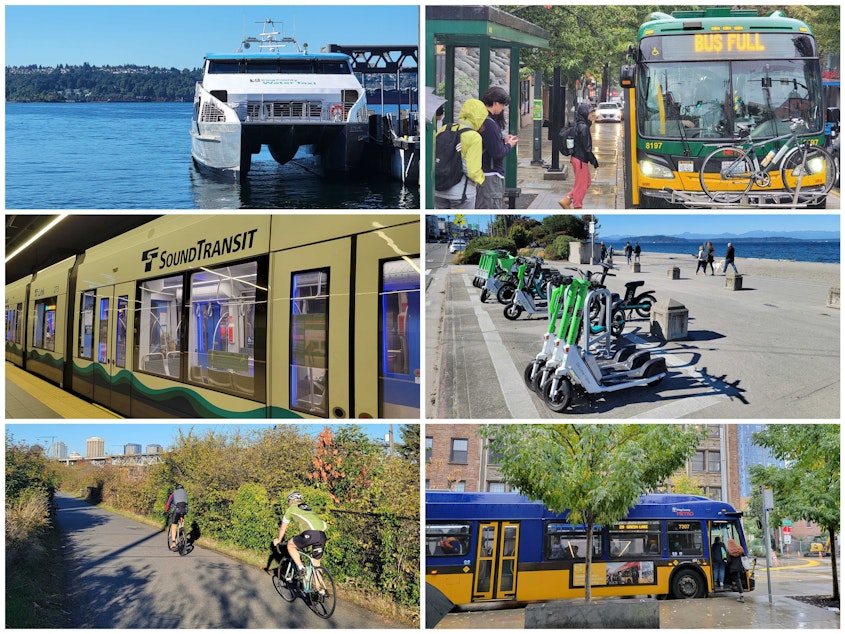Patience and planning: The ups and downs of a week without driving in Seattle

This past week people in Seattle and across the country took part in a #WeekWithoutDriving, a challenge to get out of cars and experience what getting around is like for those who can’t drive.
I spent the seven car-less days sampling as many different modes of transportation as I could, and often that meant a lot of waiting.
Traveling through town without a car means having a Plan B. And also probably a Plan C and D for good measure.
During my week without driving, I found it best to have a backup plan in case a bus didn’t show up or if the weather suddenly turned sunny and I wanted to get off light rail to walk through a neighborhood.
"It takes extra time, planning, and energy even for basic trips when driving yourself isn’t an option," said King County Councilmember Claudia Balducci in September, "and our current transportation system, which is built for and around cars, does not make it easier."
The King County Council proclaimed Oct. 2-8 as Week Without Driving, along with other counties, cities, and Gov. Jay Inslee for Washington state.
Sponsored
Many local elected leaders took part in the challenge, including Balducci.
On Monday, I waited in the rain at a packed bus stop only for Metro buses to arrive saying they were full and we’d have to wait until the next one arrived.
The next day I attempted to use Metro Flex, an on-demand shuttle hailing service that costs as much as a bus ride. I never got the app to work, however, and ended up catching a bus.
Metro wrote in an email that when I was trying to book my ride, there was a rare and unexpected disruption with their servers at Amazon Web Services.
“Over the last two months in the period that you tried to book your ride,” a spokesperson for Metro wrote, “we’ve met 99.3% of ride requests with a proposed trip, with an average wait time of around 13 minutes.”
Sponsored
Anna Zivarts, director of the Disability Mobility Initiative Program at Disability Rights Washington, the group that initiated #WeekWithoutDriving, posted on social media a Google Maps alert about 9-minute delays through downtown Seattle due to heavy car traffic.
“For nondrivers navigating transit connections or hourly/half hourly buses, nine minutes is NOTHING,” Zivarts wrote, “nine minutes is a good day.”
Wednesday and Thursday I felt a bit more independent, riding a scooter and bike instead of waiting for transit.
Riding on two-wheels was enjoyable but I had to add time to my commute in case of a flat tire or some other incident. It meant making sure all of my radio gear was weather-proofed in case of rain, something pretty common for year-round riders in Seattle.
The real challenge of scootering and cycling was feeling safe on bike paths next to busy roads and on trails that were blocked by debris.
Sponsored
There were times when a bike lane would end suddenly and I would ask myself, ‘Should I ride in the car lane? It is a shared road, after all, but cars are tailgating and angrily power-passing, so maybe not? Should I move to the cracked, bumpy sidewalk and potentially block people walking or using wheelchairs?’"
This uncertainty is what so many nondrivers experience every day in Seattle trying to get to work or the ballgame or a concert. The uncertainty when a sidewalk is covered in ice and snow, or if there’s no sidewalk at all.
“I encourage everyone to participate in this eye-opening challenge to get a better understanding of how critical it is to invest in reliable, frequent transit and safe bike/pedestrian infrastructure,” Balducci said in last month’s statement.
On Saturday, day six of the challenge, I rode a bus, light rail, and the Monorail to get to a concert at Seattle Center.
All three modes were a little late to their stops and packed with fans heading to the concert and a Seattle Sounders match. People chatted and took selfies with the Space Needle in the background. Families let their kids press their noses to the windows, looking down at the city below.
Sponsored
At the park, I knew I’d have to do the whole thing in reverse to get home — monorail, light rail, and bus. I think it’s a great way to see the city instead of the car bumper in front of you, and, with a bit of planning, it can be more rewarding, too.




